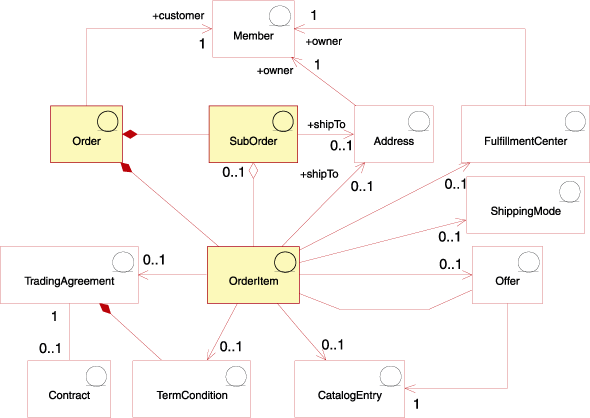Order items
Order items are the individual products or items that make up an order. Although we can create an empty order with 0 order items, this order cannot be submitted. It must contains at least one order item to be able to be processed. Each order item represents something that a customer has selected for purchase. In addition, each order item has a reference to a trading agreement (usually a contract), a shipping mode, a fulfillment center, and a price offer. Discounts, shipping charges, and total tax are stored with each order item.
The following diagram illustrates the WebSphere Commerce order item assets. Descriptions of each asset follows the diagram.
- Suborders
-
Order items are grouped to form suborders. A suborder is the part of an order that is being shipped to a specific address. For example, a customer may indicate different shipping addresses for different products in the shopping cart. Each shipping address and the products associated with it constitute a suborder. Order items in a suborder have the same shipping address, and can be used to display sub-totals of their order item amounts. But, at the same time, suborders are not an essential part of an order item.
The quantity attribute of the OrderItem object is a unitless number that can be multiplied by the nominal quantity attribute of the CatalogEntryShippingInformation object associated with the CatalogEntry object to arrive at the actual quantity represented by the OrderItem. The CatalogEntryShippingInformation object specifies the unit of measurement in which quantities are stated.
Although orders are usually associated with a single store, a special type of order that can be associated either with a store or a store group is the order profile. The order profile is represented in the object model as an Order with status of 'Q'. The order profile holds default information about a customer, such as shipping address, shipping mode, billing address and payment information.
- Other order item assets
-
An order item can be associated with zero or one of each of the following objects.
- Shipping address
- A shipping address for the customer who placed the order containing the order item. A customer must specify a shipping address during the order process, so that the store's fulfillment center can use this address to ship the order item appropriately.
- Fulfillment center
- A fulfillment center for shipping and receiving order items required by customer orders, and for storing inventory for the order item.
- Shipping mode
- A shipping mode for the order item, which is a combination of a shipping carrier (a company that provides shipping services from a fulfillment center to a customer), and the shipping service offered by that carrier. For example, ABC Shipping Company, Overnight service and ABC Shipping Company, Express delivery are shipping modes.
- Offer
- A price offer associated with the order item. By including different offers in different price lists (or "trading position containers"), stores can present different prices for the same product or SKU to different customers. For example, a travel agency may offer plane tickets in four different price lists: adult pricing, seniors pricing, children's pricing, and student pricing.
- Catalog entry
- A catalog entry for the order item; that is, each order item orders an item from a catalog.
- Trading agreement
- A trading agreement that defines the terms and conditions under which the item is ordered. This is normally a contract, but may be a
 Request for Quotation (RFQ), representing a negotiation, until the order has been submitted for processing.
Request for Quotation (RFQ), representing a negotiation, until the order has been submitted for processing. - Correlation ID
- Correlation IDs are used by ATP system to correlate order items that were split because of inventory unavailability. Since a single order item may only be assigned to one fulfillment center, if a single fulfillment center has insufficient inventory, then the order item may be split into multiple line items, each assigned to a different fulfillment center. The correlation ID is used to tie these line items together, so that they may be recombined if inventory does become available at a single fulfillment center, when the order is re-prepared at a later date.
In addition to these, there are other attributes of an order item such as requested ship date and expedite request.
Related concepts
Related tasks
Related reference
